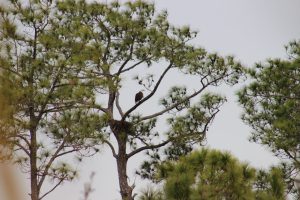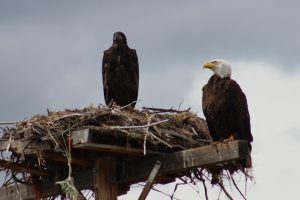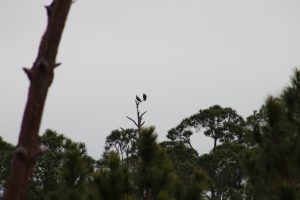On a recent trip to Santa Rosa Island, my wife saw two bald eagles flying down the shore of Santa Rosa Sound. Wanting photos of the nest, we searched and found two individuals in a small nest (for an eagle) in a tall pine. One individual was an adult, the other a juvenile.
Seeing bald eagles is like seeing bottlenose dolphins. I do not care how many times you have seen them over the course of your life, it is always exciting. Growing up here, I do not remember these animals in our area. Of course, their numbers suffered greatly during the DDT period, and poaching was (and still can be) a problem. But both the banning of DDT and the listing on the Endangered Species List did wonders for this majestic bird. They now estimate over 250,000 breeding populations in North America and 88% of those within the United States. Florida has some of the highest densities of nests in the lower 48 states. Though the bird is no longer listed as an endangered species, it is still protected by the Florida Eagle Rule, the federal Migratory Bird Treaty, and the federal Bald and Golden Eagle Protection Act.
It was shortly after Hurricane Ivan that someone told me they had seen a bald eagle in the area. My first reaction was “yea… right… bald eagle”. Then one afternoon on my back porch, my wife and I glanced up to see two flying over. Now we see them every year. The 2016 state report had 12 nesting pairs in the Pensacola Bay area. They were in the Perdido Bay area, Escambia Bay area, Holly-Navarre area, and Pensacola Beach area. Many locals now see these birds flying over our coastlines searching for food and nesting materials on a regular basis.
Bald eagles are raptors with a thing for fish. However, they are opportunistic hunters feeding on amphibians, reptiles, crabs, small mammals, and other birds. They are also notorious “raiders” stealing fish from osprey, other raptors, and even mammals. They are also known scavengers feeding on carrion and visiting dumps looking for scraps. Benjamin Franklin was in favor of the turkey for our national emblem because the bald eagle was of such low moral character – referring their stealing and scavenging habit.
The Cornell Lab of Ornithology list the bald eagle as a year-round resident along the Gulf coast, but most of us see them in the cooler months. Their nesting period is from October through May. They select tall trees near water and build their nest just below the crown of the canopy. One local ecotourism operator has noticed their preference for live trees over the dead ones selected by osprey. Eagle nest are huge. A typical one will be 5-6 feet in diameter and 2-4 feet tall. The record was a nest found in St. Pete FL that was 10 feet in diameter and over 20 feet tall! The inside of the nest is lined with lichen, small sticks, and down feathers. One to three eggs are typically laid each season, and these take about 35 days to hatch. Both parents participate in nest building and raising of the young.
Viewing bald eagles is amazing, but approaching nests with eggs, or hatchlings, can be stressful for the parents. Hikers and motorized vehicles should stay 330 feet from the nests when viewing. Bring a distance lens for photos and be mindful of your presence.
No matter how times you see these birds, it is still amazing. Enjoy them.
References
Florida Fish and Wildlife Conservation Commission. Bald Eagle Management. 2018. https://myfwc.com/wildlifehabitats/wildlife/bald-eagle/.
Jimbo Meador, personal communication. 2017.
Williams, K. 2017. All About Birds, the Bald Eagle. Cornell University Lab of Ornithology. https://www.allaboutbirds.org/guide/Bald_Eagle/overview.
- Searching for Mangroves in the Florida Panhandle - April 6, 2024
- The Swallow-tailed Kites are Back - March 30, 2024
- Beach Wildlife Walk – Late Winter - March 22, 2024



